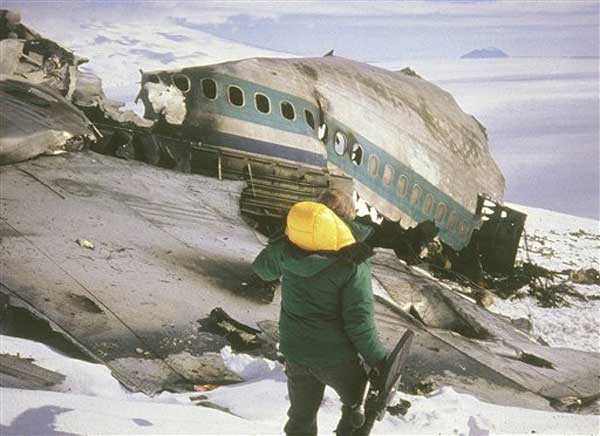|
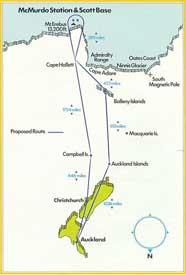 Beginning in February 1977, Air New Zealand offered tourist overflights from Auckland to the Antarctic. These flights were quite popular--in 1979 four were offered. They flew the route shown at left (from the information brochure). The last of these scheduled flights, Flight TE 901, a DC-10 with 237 passengers and 20 crew, took off from Auckland at 0820 on 28 November, on what was supposed to be an 11-hour turnaround flight. But it crashed into the side of Mt. Erebus at 1249, killing all aboard. Beginning in February 1977, Air New Zealand offered tourist overflights from Auckland to the Antarctic. These flights were quite popular--in 1979 four were offered. They flew the route shown at left (from the information brochure). The last of these scheduled flights, Flight TE 901, a DC-10 with 237 passengers and 20 crew, took off from Auckland at 0820 on 28 November, on what was supposed to be an 11-hour turnaround flight. But it crashed into the side of Mt. Erebus at 1249, killing all aboard.
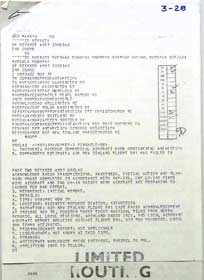 The loss of radio contact was noted at McMurdo, and Air New Zealand and the rest of the world was soon notified that communications had been lost. The Navy--Naval Support Force Antarctica (NSFA) was the primary American agency involved with the search operation...and they alerted the world with the first of several situation reports (right). This and the rest of the operational sitreps are from this page of the Archives New Zealand site mentioned below (archive site). [I wrote many Navy messages, not only while I was in the Navy, but also when I was writing sitreps and other stuff while at Pole in 1976-77. So if you are not familiar with Navy teletype messages, note the "day time group" Z 280343Z NOV 79. The numbers indicate that the message was sent on 28 November at 0343 UTC; the initial letter Z is the priority. There were 4 designated priorities--"R" being routine, 99% of messages, "P" for priority, "O" for "operational" (really important), and "Z" for "flash"--reserved for stuff like "we're being attacked, wake up the CNO and the President." (Yes, the CNO was one of the addressees.)] The loss of radio contact was noted at McMurdo, and Air New Zealand and the rest of the world was soon notified that communications had been lost. The Navy--Naval Support Force Antarctica (NSFA) was the primary American agency involved with the search operation...and they alerted the world with the first of several situation reports (right). This and the rest of the operational sitreps are from this page of the Archives New Zealand site mentioned below (archive site). [I wrote many Navy messages, not only while I was in the Navy, but also when I was writing sitreps and other stuff while at Pole in 1976-77. So if you are not familiar with Navy teletype messages, note the "day time group" Z 280343Z NOV 79. The numbers indicate that the message was sent on 28 November at 0343 UTC; the initial letter Z is the priority. There were 4 designated priorities--"R" being routine, 99% of messages, "P" for priority, "O" for "operational" (really important), and "Z" for "flash"--reserved for stuff like "we're being attacked, wake up the CNO and the President." (Yes, the CNO was one of the addressees.)]
 Soon after 2130, the time when the DC-10 would have run out of fuel, two VXE-6 LC-130 aircraft were in the air. One of these, XD-01, piloted by CDR Jack Paulus, with crew members John Jordan and Frankie Williams, was returning from Siple and Byrd, but they had limited fuel, so after a brief search they were denied permission to continue, so they returned to McMurdo to refuel. Soon after 2130, the time when the DC-10 would have run out of fuel, two VXE-6 LC-130 aircraft were in the air. One of these, XD-01, piloted by CDR Jack Paulus, with crew members John Jordan and Frankie Williams, was returning from Siple and Byrd, but they had limited fuel, so after a brief search they were denied permission to continue, so they returned to McMurdo to refuel. 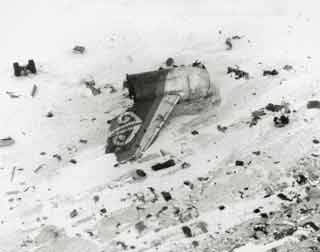 Meanwhile, another Herc, XD-03, piloted by CDR Victor Pesce was returning from Pole...they had more fuel, and the eagle-eyed copilot Ed Kionoski first sighted the crash wreckage (photos at right and left) at about 0100 on 29 November. Helicopter search parties reached the crash site at about 0900, and they quickly confirmed that the wreckage was from the ANZ aircraft, and that there were no survivors. Meanwhile, another Herc, XD-03, piloted by CDR Victor Pesce was returning from Pole...they had more fuel, and the eagle-eyed copilot Ed Kionoski first sighted the crash wreckage (photos at right and left) at about 0100 on 29 November. Helicopter search parties reached the crash site at about 0900, and they quickly confirmed that the wreckage was from the ANZ aircraft, and that there were no survivors.
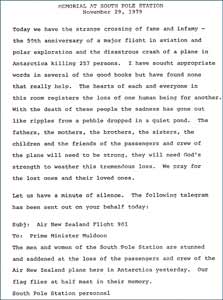 At Pole on the morning after the crash, everyone gathered inside the dome in best clothes or dress uniforms in respect for the lives lost. And the NSF representative the late Richard Cameron read the memorial seen at right (copy provided by his son Andy Cameron). Meanwhile at McMurdo, NSF representative David Bresnahan was dealing with the intensely serious search and recovery situation, not to mention a large group of DV's who's just arrived to commemorate the 50th anniversary of RADM Richard E. Byrd's overflight of Pole. At Pole on the morning after the crash, everyone gathered inside the dome in best clothes or dress uniforms in respect for the lives lost. And the NSF representative the late Richard Cameron read the memorial seen at right (copy provided by his son Andy Cameron). Meanwhile at McMurdo, NSF representative David Bresnahan was dealing with the intensely serious search and recovery situation, not to mention a large group of DV's who's just arrived to commemorate the 50th anniversary of RADM Richard E. Byrd's overflight of Pole.
News of the crash hit hard in New Zealand, as many people knew passengers who were on the flight. It also hit hard at McMurdo which was close to the crash site--here's the local news coverage from the 30 November McMurdo Sometimes.
The recovery efforts were quite extensive--in part because of pressure from Japan due to the number of Japanese citizens who had been on board. The operation lasted until 9 December; 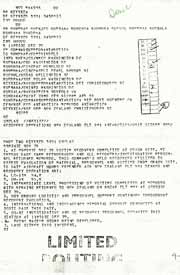 at one time there were as many as 60 recovery workers at the crash site. Recovered bodies and fragments were flown directly back to Auckland, and eventually all but 44 of the victims were identified. At right, the final NSFA sitrep, shared by Jim Mathews. at one time there were as many as 60 recovery workers at the crash site. Recovered bodies and fragments were flown directly back to Auckland, and eventually all but 44 of the victims were identified. At right, the final NSFA sitrep, shared by Jim Mathews.
 The last crash site effort was to install a memorial cross (left). It had been hand built from oak by Kiwis at Scott Base, and was used at the memorial service held there (photo of memorial service from nzhistory.net.nz with links to more information). The cross was flown to the site by helicopter, of course...due to the size of the cross, it stuck out of the open cargo door during the flight. It was erected on a nunatak about 2 miles southeast of the crash site. This photo was provided courtesy of Erich Eggers, who is seen here holding the crossbar--he was the crew chief on the flight. Japanese diplomats were part of this effort, as 24 of the casualties had been from Japan. In this photo they're stacking stones at the base of the cross. They brought two bottles of sake which they intended to pour out as a ritual, but it was really windy, so after they'd attempted to pour out half a bottle, everyone was doused, and they ended up giving Erich the unopened bottle on the way back. This nzhistory.net page shows the erected cross. The last crash site effort was to install a memorial cross (left). It had been hand built from oak by Kiwis at Scott Base, and was used at the memorial service held there (photo of memorial service from nzhistory.net.nz with links to more information). The cross was flown to the site by helicopter, of course...due to the size of the cross, it stuck out of the open cargo door during the flight. It was erected on a nunatak about 2 miles southeast of the crash site. This photo was provided courtesy of Erich Eggers, who is seen here holding the crossbar--he was the crew chief on the flight. Japanese diplomats were part of this effort, as 24 of the casualties had been from Japan. In this photo they're stacking stones at the base of the cross. They brought two bottles of sake which they intended to pour out as a ritual, but it was really windy, so after they'd attempted to pour out half a bottle, everyone was doused, and they ended up giving Erich the unopened bottle on the way back. This nzhistory.net page shows the erected cross.
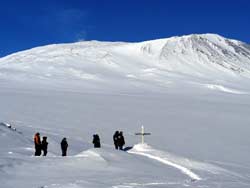
The oak cross was torn up by wind blown ice and snow; on 30 January 1987 it was replaced with a stainless steel cross depicted at right from this nzhistory.net.nz page with the larger photo.
Several inquiries were held--after mechanical failures were quickly ruled out, the focus switched to the flight crew, who had never made this particular trip before. Initially they were blamed for flying below an approved altitude, and staying there while being unsure of their location. But a second inquiry determined that the coordinates in the navigation computer had been changed without telling the crew or the flight followers at Mac Center. At the time of the crash, TE901 was flying in local whiteout conditions (in clear air under cloud cover, but with no surface definition), but most of the flight had been in clear air--if commentator Peter Mulgrew had been in
his seat a minute or two earlier he might have recognized that the aircraft was off course. As it was, the flight crew was confident of their position and flight path until the collision alarms sounded just before the crash.
The first two photos on this page were released by the New Zealand Archives as part of their 25th year remembrance which was online between 2004 and 2007; some of that information is still available here (archive site), including some of the McMurdo message traffic concerning the crash and the search efforts. Another NZ Archives page (archive site) links to the detailed accident and investigation reports. The NZ history net (another NZ government web site) has eight pages of information and photos, and the Christchurch City Libraries also has coverage--this background page with many photos and references.
The wreckage photo above showing the vertical stabilizer was by Nigel Roberts and shared by Antarctic Report on their Facebook page.
More recently the New Zealand Air Line Pilots' Association put together this site, which includes detailed information about the crash and subsequent investigations, transcripts from the "black box," and accounts from people involved with the recovery operation. Unfortunately the video is not available outside NZ.
Erich Eggers was involved with Operation Overdue--a mission to award New Zealanders and others with a special medal for those who participated in the search and recovery effort. He located a number of US Navy veterans who received the medal, as described in this April 2014 Navy Times article and this 2 May 2014 Antarctic Sun article.
Radio New Zealand has this archive of audio news reports, including some by John Blumsky, the only broadcast journalist sent to McMurdo to cover the disaster (John died around the beginning of August 2013).
Here are a couple of pages from Mike "Subs" Subritsky's NZ Antarctic Veteran's Association site--the 25th anniversary commemoration in November 2004, and the casualty list.
In 2014 the movie movie Operation Overdue was released. Highly recommended. This was followed by Erebus: Into the Unknown which was released in January 2015. Here's a (two star) review with trailer from screenrelish.com.
Other credit due for the above information...thanks to VXE-6 squadron members Victor Pesce, Frankie Williams, and John Jordan for their help.
| 